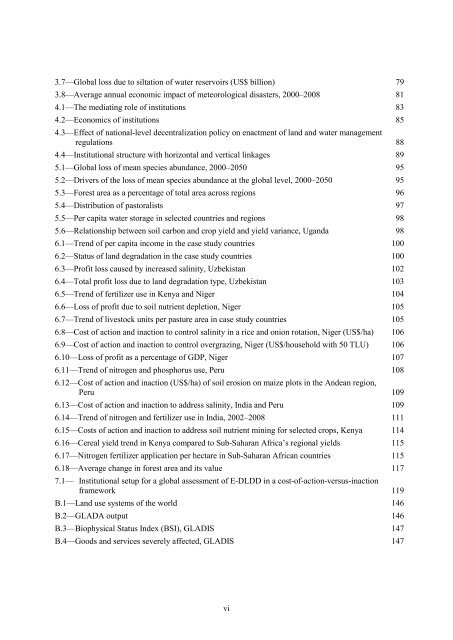The Economics of Desertification, Land Degradation, and Drought
The Economics of Desertification, Land Degradation, and Drought
The Economics of Desertification, Land Degradation, and Drought
Create successful ePaper yourself
Turn your PDF publications into a flip-book with our unique Google optimized e-Paper software.
3.7—Global loss due to siltation <strong>of</strong> water reservoirs (US$ billion) 79<br />
3.8—Average annual economic impact <strong>of</strong> meteorological disasters, 2000–2008 81<br />
4.1—<strong>The</strong> mediating role <strong>of</strong> institutions 83<br />
4.2—<strong>Economics</strong> <strong>of</strong> institutions<br />
4.3—Effect <strong>of</strong> national-level decentralization policy on enactment <strong>of</strong> l<strong>and</strong> <strong>and</strong> water management<br />
85<br />
regulations 88<br />
4.4—Institutional structure with horizontal <strong>and</strong> vertical linkages 89<br />
5.1—Global loss <strong>of</strong> mean species abundance, 2000–2050 95<br />
5.2—Drivers <strong>of</strong> the loss <strong>of</strong> mean species abundance at the global level, 2000–2050 95<br />
5.3—Forest area as a percentage <strong>of</strong> total area across regions 96<br />
5.4—Distribution <strong>of</strong> pastoralists 97<br />
5.5—Per capita water storage in selected countries <strong>and</strong> regions 98<br />
5.6—Relationship between soil carbon <strong>and</strong> crop yield <strong>and</strong> yield variance, Ug<strong>and</strong>a 98<br />
6.1—Trend <strong>of</strong> per capita income in the case study countries 100<br />
6.2—Status <strong>of</strong> l<strong>and</strong> degradation in the case study countries 100<br />
6.3—Pr<strong>of</strong>it loss caused by increased salinity, Uzbekistan 102<br />
6.4—Total pr<strong>of</strong>it loss due to l<strong>and</strong> degradation type, Uzbekistan 103<br />
6.5—Trend <strong>of</strong> fertilizer use in Kenya <strong>and</strong> Niger 104<br />
6.6—Loss <strong>of</strong> pr<strong>of</strong>it due to soil nutrient depletion, Niger 105<br />
6.7—Trend <strong>of</strong> livestock units per pasture area in case study countries 105<br />
6.8—Cost <strong>of</strong> action <strong>and</strong> inaction to control salinity in a rice <strong>and</strong> onion rotation, Niger (US$/ha) 106<br />
6.9—Cost <strong>of</strong> action <strong>and</strong> inaction to control overgrazing, Niger (US$/household with 50 TLU) 106<br />
6.10—Loss <strong>of</strong> pr<strong>of</strong>it as a percentage <strong>of</strong> GDP, Niger 107<br />
6.11—Trend <strong>of</strong> nitrogen <strong>and</strong> phosphorus use, Peru<br />
6.12—Cost <strong>of</strong> action <strong>and</strong> inaction (US$/ha) <strong>of</strong> soil erosion on maize plots in the Andean region,<br />
108<br />
Peru 109<br />
6.13—Cost <strong>of</strong> action <strong>and</strong> inaction to address salinity, India <strong>and</strong> Peru 109<br />
6.14—Trend <strong>of</strong> nitrogen <strong>and</strong> fertilizer use in India, 2002–2008 111<br />
6.15—Costs <strong>of</strong> action <strong>and</strong> inaction to address soil nutrient mining for selected crops, Kenya 114<br />
6.16—Cereal yield trend in Kenya compared to Sub-Saharan Africa’s regional yields 115<br />
6.17—Nitrogen fertilizer application per hectare in Sub-Saharan African countries 115<br />
6.18—Average change in forest area <strong>and</strong> its value<br />
7.1— Institutional setup for a global assessment <strong>of</strong> E-DLDD in a cost-<strong>of</strong>-action-versus-inaction<br />
117<br />
framework 119<br />
B.1—<strong>L<strong>and</strong></strong> use systems <strong>of</strong> the world 146<br />
B.2—GLADA output 146<br />
B.3—Biophysical Status Index (BSI), GLADIS 147<br />
B.4—Goods <strong>and</strong> services severely affected, GLADIS 147<br />
vi

















